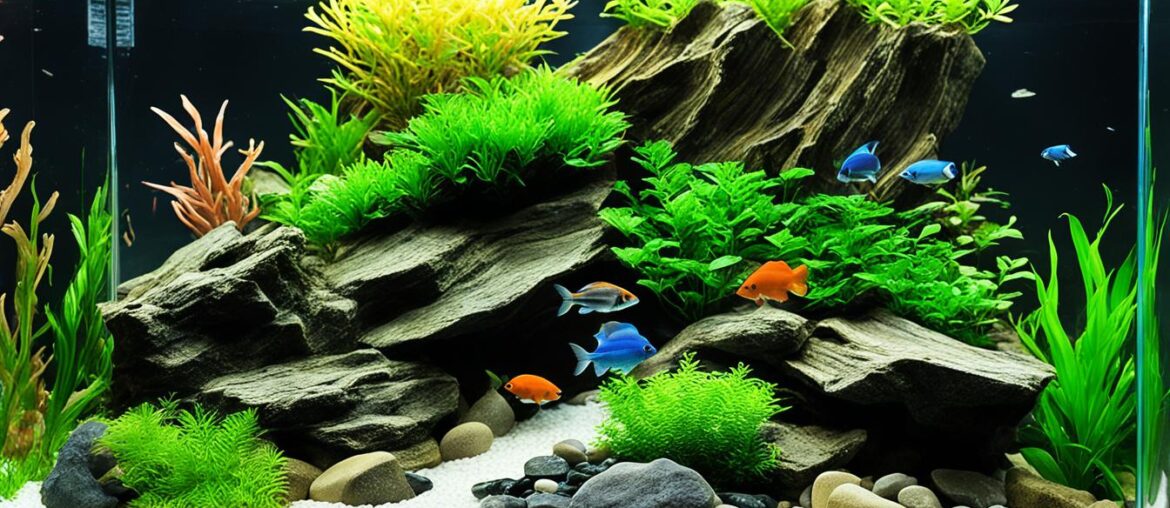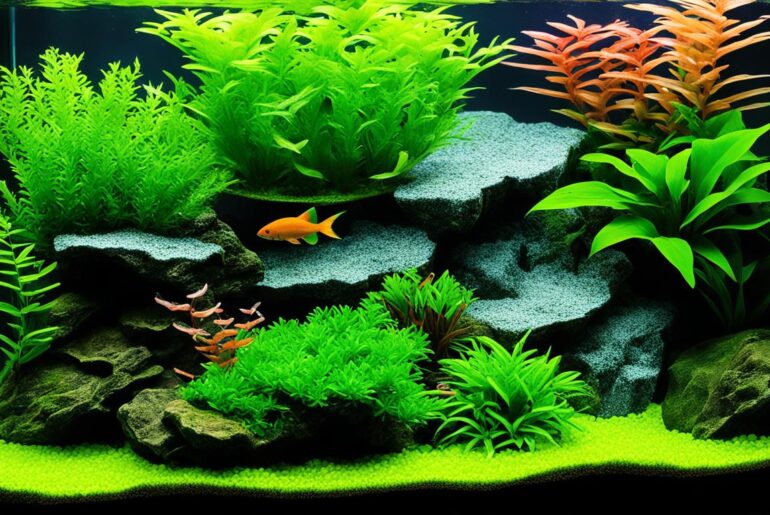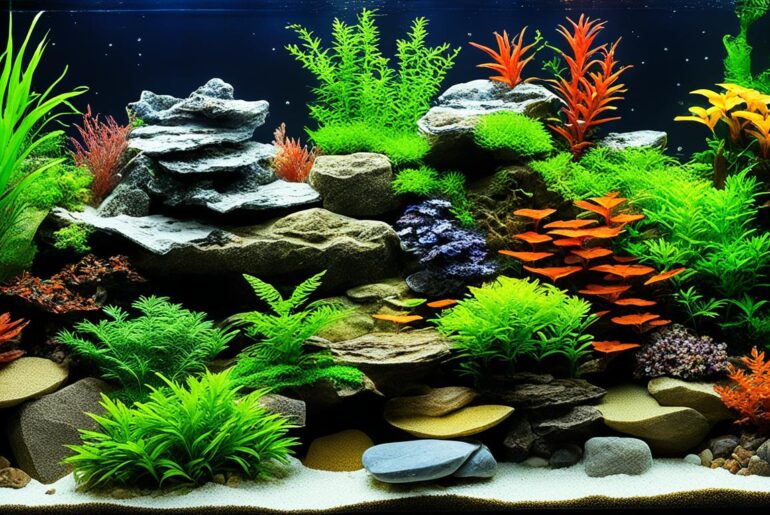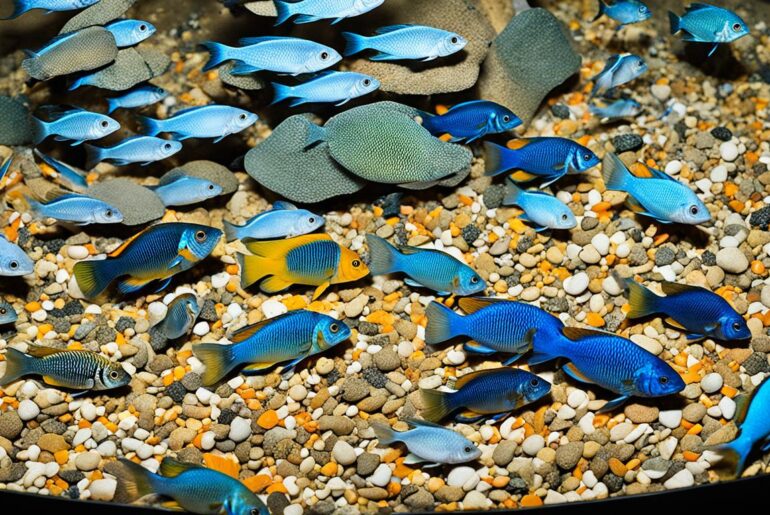When I first started my freshwater aquarium journey, I was amazed at the vibrant colors and peaceful serenity that filled my tank. It was like having a piece of nature right in my living room, a tranquil escape from the hustle and bustle of everyday life. But as I delved deeper into the world of aquariums, I realized that there was more to creating a beautiful and healthy environment for my fish and plants than meets the eye.
The choice of substrate, the material that lines the bottom of the tank, is not only crucial for the aesthetic appeal of your underwater world but also for the well-being of your aquatic inhabitants. It provides a foundation for plants to anchor their roots, promotes a healthy microbial balance, and can even impact water chemistry. That’s why it’s important to choose a natural-looking substrate that not only complements the overall design of your tank but also meets the specific needs of your freshwater setup.
Whether you’re a seasoned aquarist or just starting out, this article will guide you through the top three natural-looking substrates for freshwater setups – gravel, soil, and sand. We’ll explore their benefits, considerations, and how they can enhance the beauty and health of your aquarium. So let’s dive in and discover the perfect substrate that will bring your underwater world to life.
Key Takeaways:
- Choosing the right substrate is crucial for the aesthetic appeal and health of your freshwater setup.
- The top three natural-looking substrates for freshwater tanks are gravel, soil, and sand.
- Gravel is versatile and easy to clean, making it ideal for planted tanks.
- Soil provides a nutrient-rich base for plant growth, but requires careful maintenance.
- Sand is a natural and aesthetically pleasing option that is easy to clean.
Gravel – A Versatile and Colorful Option
When it comes to choosing a substrate for your freshwater tank, gravel stands out as a popular and versatile choice. With its wide range of colors and textures, gravel allows you to create a visually stunning and natural-looking environment for your aquatic friends. Whether you prefer a vibrant and colorful tank or a more subdued and natural-looking setup, there’s a gravel option to suit your style.
One of the key advantages of using gravel as a substrate is its ease of cleaning. Uneaten food and fish waste can be easily vacuumed up from the gravel surface, helping to maintain a cleaner and healthier tank. The process is simple, requiring only a gravel vacuum to remove any debris that has settled in between the gravel particles.
Gravel comes in various particle sizes, ranging from fine to coarse. Many fish owners prefer smaller gravel particles as they prevent debris from sinking too deeply into the substrate, making it easier to clean. Additionally, smaller gravel is less likely to be accidentally ingested by bottom-dwelling fish, ensuring their safety.
It’s important to note that when choosing gravel for your tank, you should avoid sharp-edged varieties that can potentially harm certain fish species. Look for rounded or smooth-edged gravel options to ensure the well-being of your aquatic friends.
Benefits of Gravel as a Substrate:
- Wide range of colors and textures for aesthetic appeal
- Easy to clean with a gravel vacuum
- Prevents debris from sinking too deeply
- Safe for bottom-dwelling fish
Gravel for Planted Tanks
Gravel is particularly suitable for planted aquariums due to its stability and ability to provide a solid base for plants to root. When combined with nutrient-rich layers such as aquarium soil, gravel can create an ideal environment for plant growth.
Aquarium soil, rich in essential nutrients, can be added beneath the gravel layer to provide plants with the necessary nourishment. It acts as a fertile foundation, allowing roots to penetrate and thrive. By incorporating both gravel and aquarium soil, you can create a dynamic and nutrient-rich substrate that supports the growth of lush, healthy aquatic plants.
With gravel as your substrate, you can unleash your creativity and design a stunning planted tank that showcases the beauty of both your fish and plants.
| Benefits of Gravel as a Substrate: | |
|---|---|
| Stability for plant roots | ✔️ |
| Nutrient-rich layers enhance plant growth | ✔️ |
| Wide range of colors and textures for aesthetic appeal | ✔️ |
| Easy to clean with a gravel vacuum | ✔️ |
| Prevents debris from sinking too deeply | ✔️ |
| Safe for bottom-dwelling fish | ✔️ |
Soil – Ideal for Plant Growth
Aquarium soil is specifically formulated to stay solid in water and provides an ideal substrate for plant growth. Its natural brown color adds a touch of authenticity to your freshwater tank. When combined with other colorful substrates, it creates a visually appealing and vibrant underwater environment. Not only does aquarium soil enhance the aesthetic appeal of your tank, but it also provides essential nutrients for the healthy growth of plants.
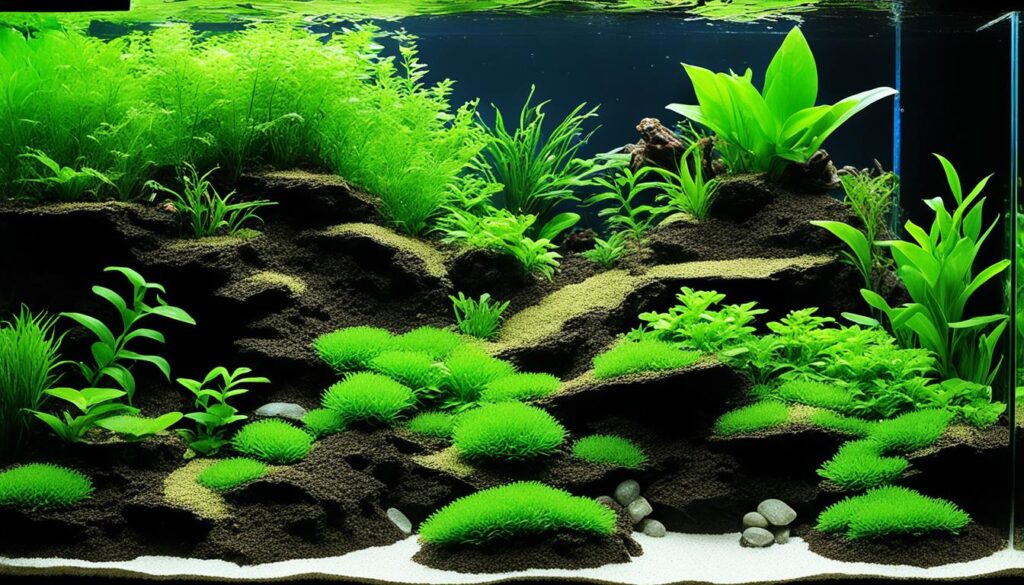
- Rich in Nutrients: Freshwater plants require a nutrient-rich substrate to thrive. Aquarium soil is specially designed to provide essential elements like nitrogen, phosphorus, and potassium, promoting the robust growth of aquatic plants. This nutrient-rich substrate helps plants to establish strong roots, ensuring their overall health and vitality.
- Avoid Outside Materials: To ensure the well-being of your fish, it is essential to use only aquarium soil and avoid adding materials from outside sources. These materials may contain harmful substances that can jeopardize the health of your aquatic inhabitants. Choosing high-quality aquarium soil specifically made for freshwater setups eliminates this risk.
- Cleaning and Maintenance: Regular cleaning and maintenance are vital to prevent the soil from contaminating the tank’s water and affecting the overall water quality. Proper cleaning techniques, such as gently stirring the top layer of soil to remove debris, help keep the substrate clean without disturbing the plants’ roots.
Remember, choosing the best substrate for your freshwater tank is crucial for supporting plant growth and creating a vibrant underwater world. Aquarium soil provides the perfect foundation for a lush and healthy planted tank.
Sand – Natural and Easy to Clean
Sand is a popular choice for freshwater setups because of its natural appeal and ease of maintenance. With its various grain sizes and colors, sand allows for creative tank designs that mimic the natural habitats of fish species. It provides a soft and comfortable substrate for fish that prefer a more delicate footing.
One of the key advantages of using sand as a substrate is its ability to prevent the entrapment of uneaten food and waste. Unlike other substrates, sand allows debris to rest on the surface, making it effortless to clean and maintain the tank’s cleanliness.
I love using sand in my aquariums. It not only creates a natural-looking environment for my fish, but it also makes cleaning a breeze. The debris sits on top of the sand, making it easy for me to vacuum it up with minimal disturbance to the tank.
Many aquascapers and hobbyists enjoy incorporating sand in their tank designs as it allows them to experiment with different styles and mix it with other substrates. Combining sand with gravel or soil can create visually appealing layers and provide additional benefits to the tank ecosystem.
To ensure the safety of your fish and plants, it is crucial to choose sand that is specifically designed for aquarium use. Rinsing the sand thoroughly before introducing it to the tank helps remove any impurities and ensures a clean and non-toxic environment for your aquatic life.
| Advantages of Sand as Aquarium Substrate | Considerations for Sand Substrate |
|---|---|
|
|
Using Multiple Layers of Substrates for Enhanced Plant Growth
Some fishkeepers choose to create multiple layers of substrates to boost plant growth in their aquariums. This technique involves layering different materials to provide optimal conditions for plant roots to thrive. By combining nutrient-rich layers with stabilizing substrates, you can enhance the overall health and aesthetic appeal of your planted tank.
Creating the Layers
To create multiple layers of substrates, start with a bottom layer of peat moss or aquarium soil. These organic materials are packed with essential nutrients that plants need to grow. They also help provide a stable anchor for roots to establish themselves. Spread this nutrient-rich layer evenly across the bottom of your tank.
On top of the peat moss or aquarium soil, add a layer of larger-grain substrate such as gravel or pebbles. This layer ensures stability and prevents the finer, nutrient-rich layer from mixing into the water column. The larger particles allow water to circulate freely, preventing the substrate from becoming too compacted.
Benefits of Multiple Layers
Using multiple layers of substrates offers several benefits for enhancing plant growth:
- Root Support: The bottom layer of peat moss or aquarium soil provides a nutrient-rich environment for plant roots to establish themselves.
- Nutrient Distribution: As water circulates through the substrate layers, nutrients are distributed throughout the tank, providing plants with ample nourishment.
- Stability: The layer of larger-grain substrate on top helps anchor plants, preventing them from uprooting easily.
The combination of these layers creates an eco-friendly system that promotes healthy and lush plant growth.
Enhancing the Natural Look
Adding decorative elements on top of the layered substrates can further enhance the natural look of your tank. Consider incorporating driftwood, both real and fake plants, and store-bought decorations to create a visually appealing underwater landscape. These elements not only add aesthetic value but also provide hiding spots and stimulation for your aquatic inhabitants.
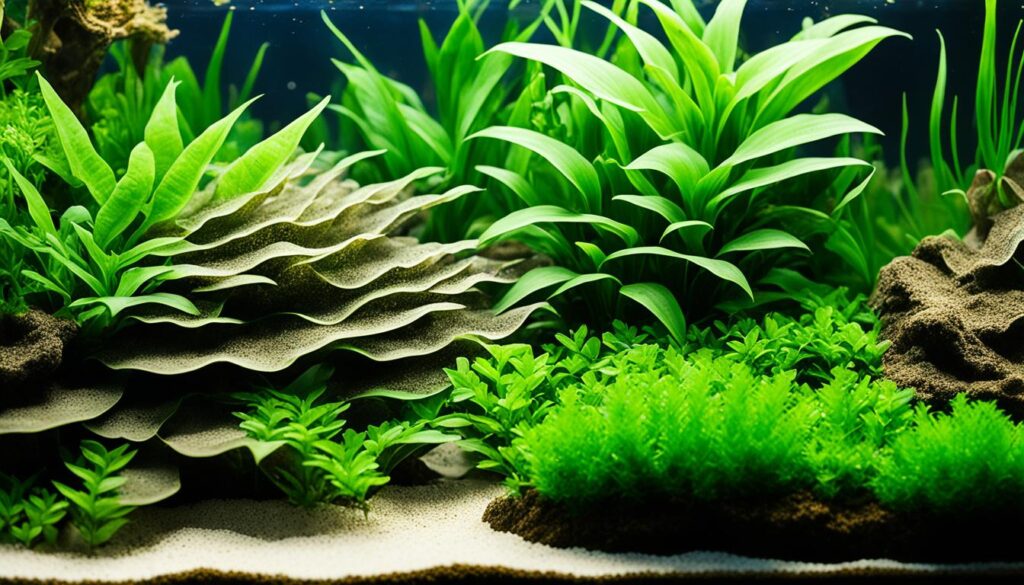
Comparison of Substrate Layers
| Layer | Material | Benefits |
|---|---|---|
| Bottom Layer | Peat Moss or Aquarium Soil |
|
| Top Layer | Gravel or Pebbles |
|
By using multiple layers of substrates in your planted aquarium, you create an ideal environment for your plants to thrive. The nutrient-rich bottom layer provides essential nourishment, while the top layer ensures stability and proper water circulation. With the addition of decorative elements, you can achieve a natural and visually stunning underwater landscape.
Other Substrate Options to Consider
In addition to gravel, soil, and sand, there are several other substrate options to consider for your freshwater setup. These substrates offer unique benefits and can enhance the health and aesthetics of your tank. Let’s explore some of these options:
Aragonite
Aragonite is a type of sand that is commonly used in reef aquariums due to its ability to raise pH levels. However, it can also be used in freshwater tanks for fish species that thrive in higher pH levels. Aragonite comes in different forms, including fine sand and larger gravel-like particles. Adding aragonite to your tank can help create a more alkaline environment, which is beneficial for certain fish and coral species.
Vermiculate
Vermiculate is a mineral mixture that can be used as a substrate for tanks with multiple substrates. It is particularly beneficial for planted tanks as it provides essential nutrients to promote plant growth. Vermiculate has excellent water retention properties, which helps keep the plants hydrated. By adding vermiculate to your tank, you can create a nutrient-rich environment that supports the health and vitality of your aquatic plants.
Peat Moss
Peat moss is a popular choice for freshwater aquariums, especially for fish species that prefer soft and slightly acidic water. It can naturally soften the water and buffer pH levels. However, peat moss requires additional preparation steps before it can be added to the tank. It is important to rinse it thoroughly and soak it in water to remove any impurities and excess tannins. By using peat moss as a substrate, you can create a more natural and comfortable environment for your fish.
Crushed Corals and Marbles
If you have specific fish species that require a higher pH level, crushed corals or marbles can be used as a substrate. These substrates slowly release calcium carbonate, which helps maintain a stable pH level in your tank. However, it is important to note that crushed corals and marbles may not be suitable for all fish species. It is essential to research the compatibility and specific requirements of your fish before adding these substrates to your tank.
Clay Substrates
Clay substrates, such as fluorite, are excellent choices for planted tanks. They provide a stable base for plants to anchor their roots and promote healthy growth. Clay substrates also have the added benefit of water filtration, as they can absorb and trap impurities, keeping the water clean and clear. However, clay substrates may require more frequent tank cleaning to prevent them from becoming compacted.
| Substrate | Description |
|---|---|
| Aragonite | Raises pH levels, suitable for fish species that thrive in higher pH |
| Vermiculate | Provides nutrients for plants, ideal for planted tanks |
| Peat Moss | Naturally softens water and buffers pH levels |
| Crushed Corals and Marbles | Maintains pH levels for fish species that require higher pH |
| Clay Substrates | Promotes plant growth and provides water filtration |
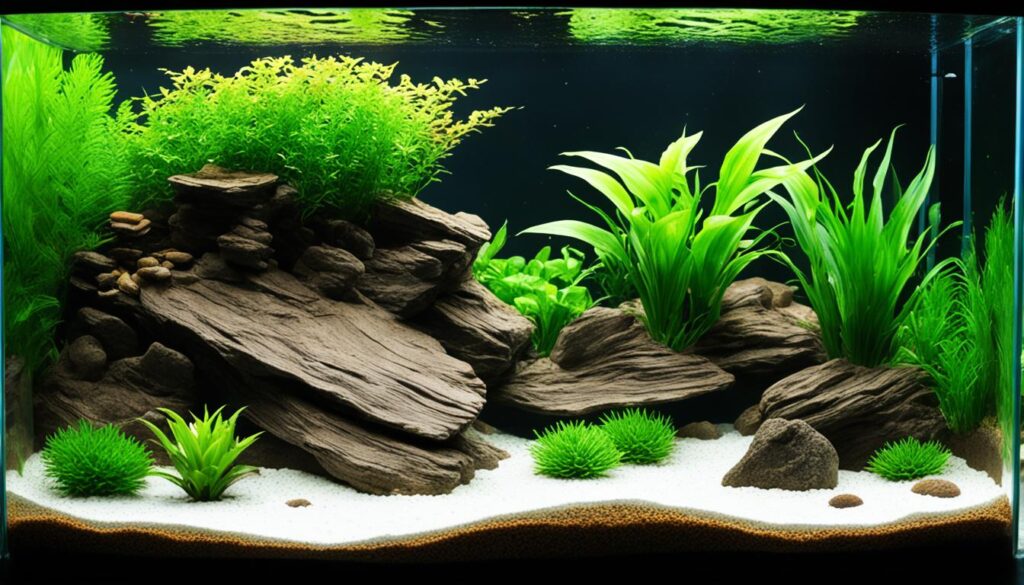
Exploring these alternative substrate options opens up a world of possibilities for your freshwater tank. Each substrate has its own unique characteristics that can cater to the specific needs of your fish and plants. Take the time to research and consider the requirements of your aquatic inhabitants before making a decision, ensuring that you create a thriving and visually appealing environment in your aquarium.
Substrate Additives for Improved Performance
In addition to choosing the right substrate, adding substrate additives can enhance the overall performance of your tank. These additives are specifically designed to provide numerous benefits to your aquarium ecosystem. They can boost nutrient availability, promote healthy plant growth, improve water filtration, and even help maintain appropriate pH levels. When selected and used correctly, substrate additives can significantly enhance the health and vitality of your aquatic environment.
There are various types of substrate additives available on the market, each offering specific advantages. Some additives contain essential nutrients such as iron, potassium, and magnesium, which are essential for proper plant development. By supplementing your substrate with these nutrients, you can create an optimal environment for lush and vibrant aquatic plants.
“Substrate additives can make a noticeable difference in the health and growth of your plants. They provide the necessary nutrients and elements that may be lacking in your tank, resulting in thriving plant life.”
In addition to their nutrient content, some additives are formulated to improve water filtration. They can help remove harmful substances, such as heavy metals and excess nutrients, from the water column, resulting in a cleaner and healthier environment for your fish and plants.
Another essential role that substrate additives can play is in buffering pH levels. Some additives are specifically designed to stabilize the pH of the water, ensuring that it remains within the optimal range for the inhabitants of your freshwater tank.
When selecting substrate additives, it is important to consider the specific needs of your tank and fish species. Research the different options available and choose additives that are compatible with your substrate and tank inhabitants. Following the manufacturer’s instructions for dosage and application is crucial to ensure the effectiveness of the additives while avoiding any negative effects on the tank ecosystem.
Using substrate additives in combination with the appropriate substrate can create a dynamic and thriving aquatic environment. These additives can contribute to the overall health and beauty of your tank, setting the stage for a visually stunning and ecologically balanced freshwater setup.
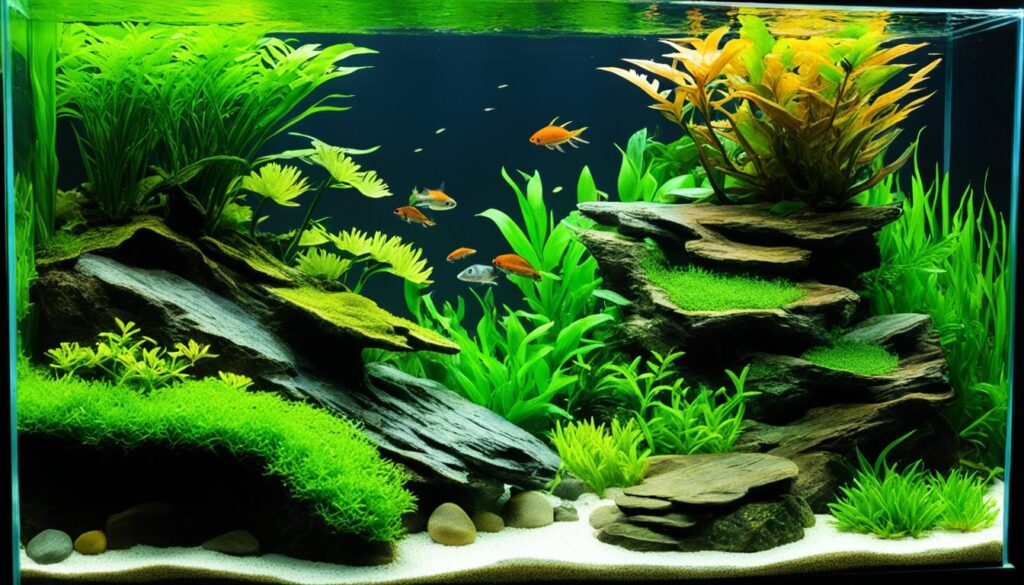
Benefits of Substrate Additives:
- Enhanced nutrient availability for plants
- Promotion of healthy plant growth
- Improved water filtration
- Stabilization of pH levels
- Creation of a balanced and thriving ecosystem
Key Factors to Consider When Choosing a Substrate
When it comes to selecting the best substrate for your freshwater aquarium, there are several key factors to take into consideration. These factors will help ensure that you choose a substrate that not only meets the specific needs of your fish species but also enhances the overall aesthetic appeal of your tank. Here are the essential elements to keep in mind:
- Tank Size: The size of your tank will influence the type and quantity of substrate you need. Larger tanks may require more substrate to cover the bottom evenly, while smaller tanks may benefit from a thinner layer for ease of cleaning and maintenance.
- Fish Species: Different fish species have different substrate preferences. Some may require soft substrates like sand, while others may prefer a more natural-looking gravel. It’s important to research the needs and behavior of your fish species to choose a substrate that supports their well-being.
- Aesthetic Appearance: Consider the overall look you want to achieve in your aquarium. Do you want a natural and earthy look with soil and plants, or a vibrant and colorful display with bright gravel? The substrate you choose will significantly impact the visual appeal of your tank.
- Compatibility: Take into account the compatibility of your chosen substrate with other tank elements such as live plants, rocks, and decorations. Some substrates may interact with certain elements or affect the water chemistry, so it’s important to ensure compatibility for a healthy and balanced aquarium environment.
To make an informed decision, I highly recommend researching different substrate options, reading customer reviews, and seeking advice from experienced fishkeepers. Their insights and recommendations can provide valuable guidance in choosing the best substrate for your specific tank requirements.
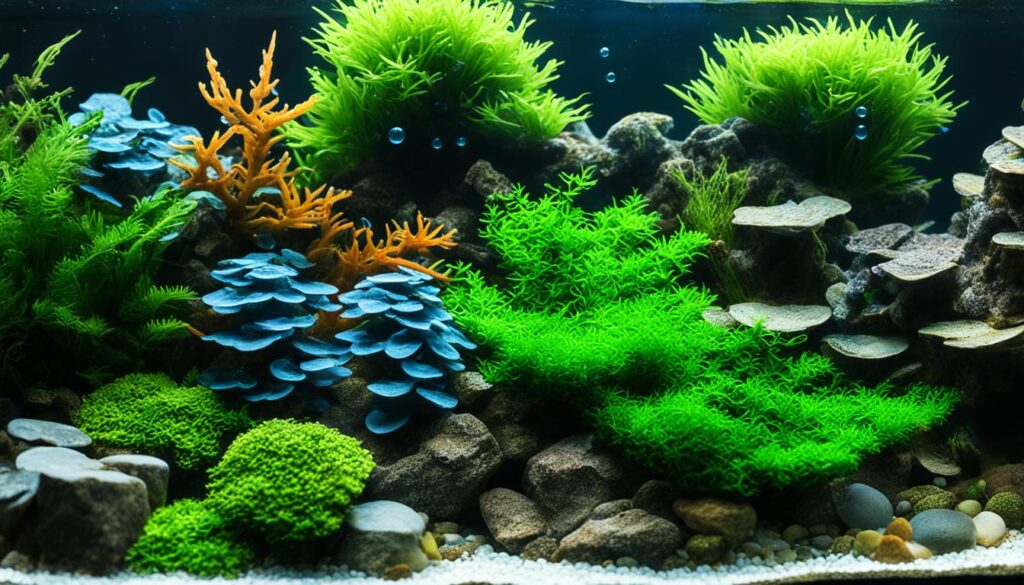
By considering these key factors, you can select a freshwater aquarium substrate that not only meets the needs of your fish but also enhances the visual appeal of your tank. Let’s dive into the next section where we explore proper application and maintenance techniques for your chosen substrate.
Proper Application and Maintenance of Substrates
Once you have chosen the appropriate substrate for your freshwater setup, it is important to ensure proper application and maintenance. By following these guidelines, you can create an ideal environment for your aquatic plants and maintain a healthy tank.
Rinsing the Substrate
Before adding the substrate to your tank, it is essential to thoroughly rinse it to remove any impurities. This will help prevent debris, dust, or chemicals from entering your tank and potentially harming your fish and plants. Use a fine mesh strainer or colander to rinse the substrate under running water until the water runs clear.
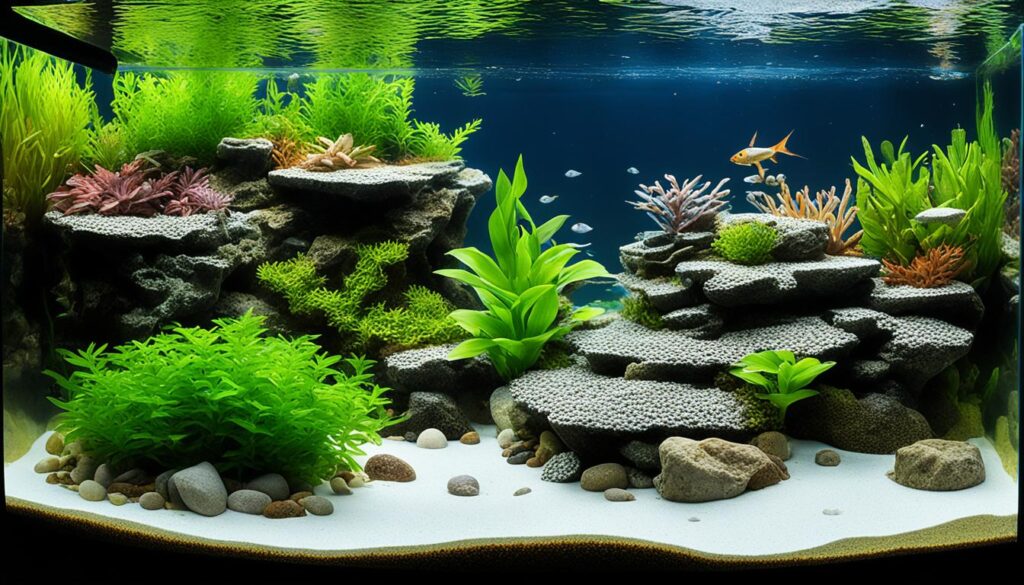
Layering Substrates for Planted Tanks
For planted tanks, layering different substrates can provide optimal conditions for plant growth. Start with a nutrient-rich layer such as aquarium soil or specialized planted tank substrate. This layer will provide essential nutrients for the plants’ root development. On top of the nutrient-rich layer, add a layer of gravel or sand to promote stability and prevent the soil from being disturbed during maintenance.
Regular Cleaning and Maintenance
To prevent the substrate from becoming compacted or contaminated, regular cleaning and maintenance are necessary. Use a gravel vacuum or siphon to remove debris, excess food, and waste material from the substrate. This will help maintain water quality and prevent the accumulation of harmful substances. Additionally, regularly check and adjust water parameters such as pH, temperature, and ammonia levels to ensure a healthy and balanced aquatic environment.
Creating a Beautiful and Balanced Aquatic Environment
Properly applying and maintaining the substrate is essential for creating a beautiful and balanced aquatic environment. The right substrate provides a natural look to your tank while supporting the growth of aquatic plants. By following the guidelines for substrate application and regular maintenance, you can enjoy a thriving planted tank with healthy and vibrant aquatic plants.
Enhancing Aesthetics and Health with the Right Substrate
Choosing the right substrate for your freshwater setup is essential for both the visual appeal of your tank and the well-being of your fish and plants. Natural-looking substrates, such as gravel, soil, and sand, not only create an attractive base for your tank but also provide a more natural environment for your aquatic inhabitants.
Gravel is a versatile option that comes in a wide range of colors, allowing you to customize the look of your tank to suit your preferences. Its ease of cleaning makes it a popular choice, as debris can be easily vacuumed from the surface. Gravel provides a stable base for plants to root, especially when combined with nutrient-rich layers such as aquarium soil.
Soil is specifically formulated to stay solid in water and is ideal for promoting plant growth in your aquarium. It comes in natural brown colors that add a touch of authenticity to your tank. Aquarium soil is rich in nutrients, which helps plants thrive. However, it’s important to use only aquarium soil and avoid adding materials from outside sources, as they can be harmful to your fish.
Sand is a natural and visually appealing substrate choice for freshwater setups. It comes in various grain sizes and colors, allowing for creative tank designs. Sand is particularly suitable for fish species that prefer a soft substrate. Its smooth texture prevents uneaten food and waste from getting trapped, making it easy to clean. Many aquascapers enjoy using sand to create unique styles and often mix it with other substrates.
“Choosing the right substrate is not just about aesthetics. It is about creating a healthy and balanced environment for your fish and plants to thrive.”
By considering the specific needs of your fish species and plant choices, you can create a beautiful and thriving freshwater setup that you will enjoy for years to come. A carefully selected substrate provides a solid foundation for the growth of aquatic plants, while also ensuring the well-being of the fish species in your tank.
Aside from aesthetics and health benefits, natural-looking substrates also contribute to the overall enjoyment of your aquarium hobby. They help create a more immersive experience, resembling the natural habitats of your fish and bringing a sense of tranquility to your space.
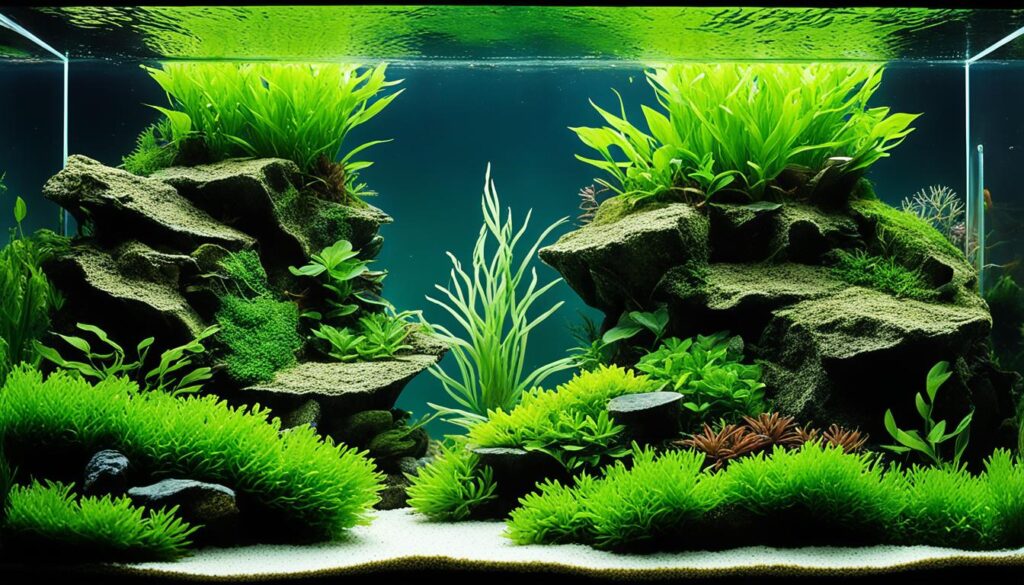
Conclusion
In conclusion, choosing the best natural-looking substrate for your freshwater setup is a crucial decision that will greatly impact the aesthetics and health of your tank. Among the top substrate options, gravel, soil, and sand offer different advantages and considerations.
Gravel is a versatile choice that comes in a wide range of colors, allowing you to create a visually appealing tank. Its surface is easy to clean, making it ideal for busy fishkeepers.
Soil substrate, on the other hand, is specifically formulated to promote plant growth, providing essential nutrients for your aquatic flora. It creates a rich environment that encourages healthy root development.
Lastly, sand creates a natural-looking and easy-to-clean foundation for your tank. With various grain sizes and colors available, you can achieve a unique and visually appealing setup. Sand is well-suited for fish species that prefer a soft substrate and avoids trapping debris, ensuring a cleaner environment.
When selecting your substrate, consider the specific needs of your tank, such as the size of your tank, the preferences of your fish species, and the compatibility with other tank elements. By properly applying and maintaining your chosen substrate, you can create a thriving freshwater setup that delights the eye and promotes the health and longevity of your aquatic ecosystem.
FAQ
What are the top three natural-looking substrates for freshwater setups?
The top three natural-looking substrates for freshwater setups are gravel, soil, and sand.
Why is gravel a popular choice for freshwater tanks?
Gravel is a popular choice for freshwater tanks due to its versatility, wide range of colors, and easy cleaning.
What are the benefits of using aquarium soil as a freshwater substrate?
Aquarium soil provides an ideal substrate for plant growth, is rich in nutrients, and promotes the healthy growth of plants.
What makes sand a natural and easy-to-clean substrate option for freshwater setups?
Sand is a natural and aesthetically pleasing substrate option, comes in various grain sizes and colors, and is easy to clean.
How can using multiple layers of substrates enhance plant growth in freshwater tanks?
Using multiple layers of substrates provides optimal conditions for plant growth, with a bottom layer for nutrients and root support, and a top layer for stability.
What are some other substrate options to consider for freshwater setups?
Other substrate options to consider include aragonite, vermiculate, peat moss, crushed coral, marbles, and clay substrates.
How can substrate additives improve the performance of a freshwater tank?
Substrate additives can increase nutrient availability, promote plant growth, aid in water filtration, and buffer pH levels.
What factors should be considered when choosing a substrate for a freshwater setup?
The size of the tank, specific needs of the fish species, desired aesthetic appearance, and compatibility with other tank elements should be considered when choosing a substrate.
How should substrates be properly applied and maintained in a freshwater tank?
Substrates should be thoroughly rinsed before adding them to the tank, and regular cleaning and maintenance are necessary to prevent compaction or contamination.
How can the right substrate enhance the aesthetics and health of a freshwater tank?
Choosing the right substrate creates a visually appealing base, provides a natural environment for aquatic inhabitants, and promotes the health and well-being of fish and plants.
